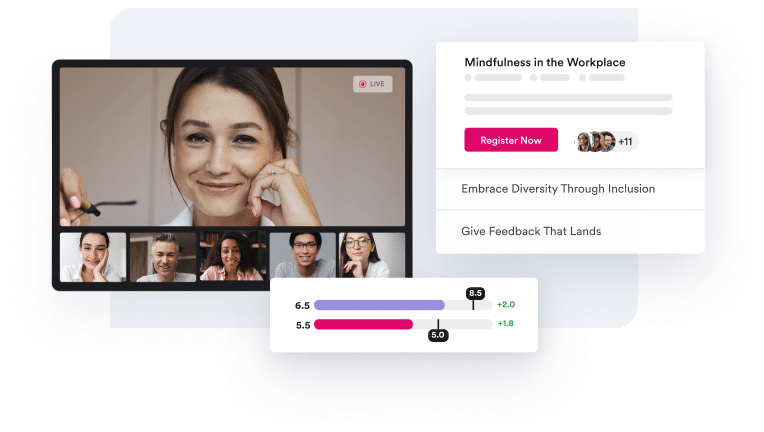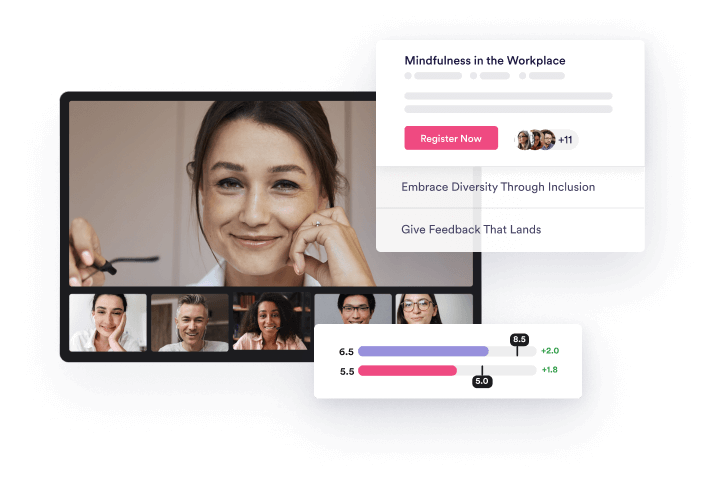Change shakes up our world and unsettles us. One thing that eases the challenges of change is a great support team. Whether that support is a good luck call before your first day of work, a family member dropping off a lasagne, or your partner making you a new workout playlist, people are key supports during change. The same concept extends to organizations, which are, at their essence, a network of people all playing their part. Focusing on these change network roles is essential to developing and executing organizational change management strategies.
This article examines the key relationships found in most change networks. As a result, you’ll come away with a better understanding of how these players affect change management and how to best work with them when carrying out an initiative.
What is a change network?
The definition of a change network refers to a group of individuals or organizations that work together to drive change in a specific domain or field. These networks typically involve collaboration among stakeholders with diverse backgrounds, experiences, and perspectives who come together to pursue a common goal or objective.
The primary purpose of a change network is to create a platform for sharing knowledge, resources, and expertise among members and foster collective action toward a shared vision of change. Change networks can be formed at various levels, from local grassroots movements to international organizations. They can focus on a wide range of issues, including social justice, environmental sustainability, public health, and economic development.
How do you assemble a change network?
The first order of business is assembling your change network team. Next, you must identify your change management champions, sponsors, and internal stakeholder and determine how to best engage them in the change. So, who exactly are these people in your change network? Let’s meet your change network.
Champion Characteristics
Every change management initiative needs a champion. These passionate advocates for change rally the troops and drive adoption and engagement with change management strategies. They also provide insight to help the team navigate the choppy waters of change. When a champion speaks, colleagues listen.
Being a formal leader in the organization is not necessary. Champions are well-respected and trusted teammates with the influence and credibility to promote the change initiative. Champions’ enthusiasm and insight add value when the change initiative runs into headwinds. They typically enjoy being early adopters and, as a result, can roll with the inevitable obstacles and setbacks that arise by navigating around or through them.
The stature and respect of the champion are complemented by their strong communication skills and ability to see the big picture and interconnecting threads. These gifts allow the champion to educate more reluctant participants regarding the subsequent benefits of the change. In addition, champions can respond confidently to worries and concerns, lowering the temperature in the room and offering workable solutions.
Sponsor Characteristics
Sponsors are senior leaders that provide the resources for the change initiative as well as concrete help to overcome barriers or resistance. Their domain and process expertise often enables them to quickly identify potential obstacles and needs. In addition, sponsors often manage teams carrying out change management strategies, bringing knowledge of their area’s function, priorities, and resources to the table.
Make no mistake, sponsors are not mere managers. They have a strong understanding of change management principles and the experience to coach others through change. Managers focus on planning and short-term horizons, devise processes and structures, and solve problems. In contrast, sponsors establish direction for the future, communicate through vision, and forge aligned, high-performance teams.
In 1992, Daryl R. Connor defined the characteristics of strong sponsors. Sponsors have the organizational power to drive change and position it as a net positive. They have a strong sense of urgency necessary to continue pushing for change even when others are uncertain.
Sponsors have a vision of the benefits of the change and the organizational clout to demonstrate senior leadership’s commitment. When words and vision aren’t enough, sponsors tap their power and leverage to bring others on board, meeting privately with key players to move things forward.
Internal Stakeholder Characteristics
Internal stakeholders are colleagues directly affected by the change and must change something about how they do their job as a result. Internal stakeholders may need to learn new skills, behaviors, and processes to support and align with the new reality.
Internal stakeholders sometimes get involved in implementing the change. As a result, they possess the most information about the current state and existing processes potentially impacted by the new vision or the change process itself.
Internal stakeholders are often the forgotten heroes of your change network. But unfortunately, while the change may benefit the entire organization, in the short term, it’s also likely to disrupt the work of internal stakeholders.
Most critically, however, internal stakeholders live where the rubber meets the road. Their input and perspective can distinguish between success and failure, adoption or rejection.
Internal stakeholders have the widest range of characteristics. Some may be individual contributors with deep domain expertise. Others may value the consistency of their day-to-day routine. Some internal stakeholders are energized by change and the thought of making the organization better, while others may greet it with cynicism or skepticism.
Research from Gartner discovered that 73% of employees going through a change management initiative say they experienced moderate-to-high stress levels. Change agents ignore the importance and insight of internal stakeholders at their peril.
Bringing your Change Network Together
After surveying your organization and identifying a champion, sponsors, and internal stakeholders, it’s time to engage your change network and rally the troops. Successful change agents consistently do the following things with their change network:
Engage the Change Network
Convene your network. Make sure it’s aligned with your existing company culture. More formal companies with many employees may opt for a kickoff meeting. Smaller or less formal companies may have a series of more minor conversations.
Your champion is key in engaging your network and setting the tone. They have the respect and power in the organization to make things happen. The Champion sets a positive and engaging style while realistically acknowledging the hard work ahead, and that change will require everyone to be flexible and collaborative.
Establish Roles, Responsibilities, and Processes
It is vital to clearly establish the expectations for each player and how everyone will work together. Ideally, your champion knows their role before convening. But everyone must understand their roles and those of their fellow participants.
The process also counts. Whether you run your change initiative as a waterfall project, use an agile approach, or adopt some other framework, your team must walk away knowing a few things:
- How often do meetings occur
- The designated communication channels and cadences
- Each person’s role in cascading the communication within their areas
- How to escalate and address issues and showstoppers
Tap the Change Network for Expertise
You’ve chosen your change network carefully. Now is the chance to infuse your initiative with their wisdom.
Sponsors typically lead a function that will be affected by the change and likely will have some role in executing it. Mine these experts to map out challenges, identify critical chunks of work that need to occur, and estimate resource needs.
As a change agent, you must understand all the dependencies between different components of the change, communicating and coordinating tasks so sequencing and dependencies are clear from the outset.
Now is not the time for sweeping assumptions. Your stakeholders know more about the hidden ripple affects the change initiative will spawn. Engage them and their insight early on.
Communicate, Communicate, Communicate
Change is unsettling for most people. Communication cannot remove that angst, but it can go a long way toward calming the choppy seas.
The change network may be invigorated and ready to jump in with both feet. But others are wondering, “What does this mean for me? How will my role and work activities change? How long until the change process is complete?”
You can’t answer these questions immediately. However, consistent, transparent, and frequent communication about the change is vital. Champions speak to the entire organization about the rationale for this change. They elaborate on the opportunities it creates while acknowledging colleagues’ discomfort.
Sponsors communicate more granularly to their team or function–providing information and direction and soliciting feedback, updates, and surfacing issues. Sponsors also communicate with each other to understand obstacles and brainstorm solutions.
Don’t forget internal stakeholders. They frequently do the heavy lifting of the change or are directly affected. Internal stakeholders can distinguish between a change initiative that feels like pulling teeth and one that sees an entire organization pulling together.
Supercharge your Change Management Strategies Toolbox
You’re not alone if you feel a bit daunted by using new change management strategies to wrangle a diverse team of people to create change. Check out Hone’s classes on conflict resolution, change management, and working effectively with others to boost your confidence to lead your network to change management success.








